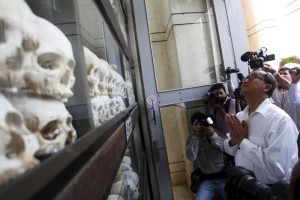April, 2015
now browsing by month
Comment from MP Mu Sochua and the following healing processes
After publishing the article “40 years of memoir, story telling, healing, and moving forward for all Cambodians“, we wish to share the comment from MP Mu Sochua and the comment from the author, Mr. Soph0an Seng as following:
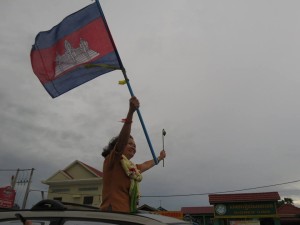 You have my deepest appreciation and respect for your invaluable compilations and your own articles of all the painful memories relived and told by those who can not forget and forgive. I read them all with the vivid images of my own parents and blind grand-mother among the millions who believed in the lies of the Khmer Rouge and left the city as they were told. I did not live with the Khmer Rouge regime but as a Khmer woman, the suffering of not saying goodbye to my beloved parents and to my grand-mother with whom I shared my adolescent years have been with me for the past 40 years.
You have my deepest appreciation and respect for your invaluable compilations and your own articles of all the painful memories relived and told by those who can not forget and forgive. I read them all with the vivid images of my own parents and blind grand-mother among the millions who believed in the lies of the Khmer Rouge and left the city as they were told. I did not live with the Khmer Rouge regime but as a Khmer woman, the suffering of not saying goodbye to my beloved parents and to my grand-mother with whom I shared my adolescent years have been with me for the past 40 years. Sent from my iPad
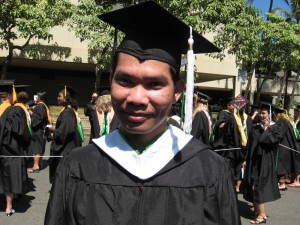 I am greatly complimented by partnering healing processes through telling my story and hearing your story: I do believe in “story telling” to accumulate fresh first hand information and to heal Khmer’s mental illness and PTSD.
I am greatly complimented by partnering healing processes through telling my story and hearing your story: I do believe in “story telling” to accumulate fresh first hand information and to heal Khmer’s mental illness and PTSD.
Posted in Culture, Economics, Education, KR Trial, Leadership, Politics, Researches, Social | Comments Off on Comment from MP Mu Sochua and the following healing processes
Tags: Khmer Rouge, Khmer Rouge Tribunal, Mu Sochua, Sophoan Seng
40 Years of Memoir, Story Telling, Healing and Moving Forward for all Cambodians
This 40 years, it is my first time to recall back my past turbulence and my family. I was born at an architectural still house in the heart of Siem Reap in 1976, one year after the ascending to power of the Khmer Rouge. I am recalled by mother since I was very young on many things that I am having difficulty to remember. I have remembered clearly only my birthday I was frequently asked to recite it in Khmer traditional lunar calendar. My father passed away since I was in the womb. I have never seen the face of my father even though through the photo. Mother told that all family pictures and photos were totally destroyed to avoid catching up as enemy and facing death penalty. My mother passed away when I was 11 years old. The bitter story has later little been told by my survival two older sisters. All my four siblings were killed during the regime. I have no clue tills today that how could I pen about them or figure out about their face accurately?
During the Khmer Rouge period, I have no memory at all except some flashing image occurring within my head on how bad I was crying inside the Buddhist worshiping hall to ask for mom and to scavenge for food to eat. But I remembered the starvation and famine during the presence of Vietnamese solders patrolling surround my house in Phum Dang-het, Srok Chi Kraeng. I think during 1979 to 1980, there was famine throughout the country.
Brief memory recalling by Sophoan Seng
In commemoration of 40 years when the Khmer Rouge came to power to lead a country of extremism and jungle leadership.
This is the 40 years of memos, healing, story telling, and moving forwards. Please, watch this video clip by RFA
Botta, the high commissioner for youth and sports, stands at the end of a row of suited men, arms behind his back, staring defiantly into the camera. Lon Nol, the mystic “Marshal” that led the ill-fated and highly corrupt republic, stands in the middle, leaning on his cane but still towering over the rest.
“Most of them were killed by the Khmer Rouge,” Botta, now 72 and an opposition MP, says.
It has been exactly forty years since the Khmer Rouge marched into Phnom Penh on April 17, 1975.
By The Diplomat
**************
The stories I have heard since I was a young child continue haunt me, and the bits and pieces of the puzzle never quite formed a solid picture of what really happened. Forty years later, the story of my family’s experience was still a mystery to me. While other stories from survivors were clear in my mind, I never heard the entire story from my parents, until now. Perhaps it was my frequent visits home, with cohorts of inquisitive graduate students that prompted me to ask, in detail, the story I had wanted to hear. It was never a question that surfaced in my mind as one that should be asked. As a child of genocide survivors, it was something I feared, something I ignored. Yet, the more students I brought to Cambodia, the more their questions made me realize that the genocide was something that needed to be told. My family’s story was not something to be ignored, but rather something to be acknowledged, both for the survivors themselves and for their children. And so begins the story of one family, who much like the rest of the Khmer people, faced tragedy and immeasurable sorrow, and somehow found a way to survive.
“Story Telling by Dr. Sothy Eng” by Huffington Post
*********************
Sophal Ear, SEARAC Board Member, Occidental College Professor of Diplomacy & World Affairs, and TED Fellow, tells the compelling story of his family’s escape from Cambodia under the rule of the Khmer Rouge. He recounts his mother’s cunning and determination to save her children in his 2009 TED Talk, “Escaping the Khmer Rouge.” His mother passed away six months later.
“Story Telling by Dr. Sophal Ear” by SEARAC and TEDtalks
********************
On April 17, 1975 — 40 years ago today — life as Ly knew it was shattered when her hometown, the Cambodian capital of Phnom Penh, fell to the genocidal Khmer Rouge regime of the Communist Party of Kampuchea.
Ly, then 13, was separated from her mother and two of her sisters who, along with virtually the entire population of Phnom Penh — about two million people — were sent on a forced march into the countryside to work.
Ly never saw them again, nor learned what happened to them. But about 20,000 people died from execution, starvation or exhaustion during this exodus at gunpoint, according to war crimes prosecutors; the others were subjected to slave labor in rural camps once they reached their destination, where many met similar fates.
“Story Telling by Ly and her unexpected family reunion” by CNN
**************
“The children’s arrival was not all smooth and happy,” recalls Gaffar Peang-Meth, who became the point man for verifying many of their legal status. Some news media reports suggested that the children were not all orphans and openly questioned why they had been brought to the U.S. Gaffar Peang-Meth responded that there was no authority in Phnom Penh to answer such allegations.
Amid the mounting concern, the Immigration and Naturalization Service (INS) ordered a temporary halt to the babylifts on April 16, just one day before the Khmer Rouge seized Phnom Penh. Then deputy commissioner of the INS, James Green, told the Washington Post that the agency would “launch a full investigation to determine what these children’s backgrounds are and how they got into the United States.”
TIME recalled the halting of adopting orphanages few days before KR seized Phnom Penh by TIME Magazine
*******************
A few hundred people, including monks and elderly regime survivors, gathered early Friday at Choeung Ek, the most notorious of the regime’s “killing fields” on the capital’s outskirts, burning incense and saying Buddhist prayers at a memorial stupa housing the skulls and bones of victims.
Cambodia’s opposition leader, Sam Rainsy, led prayers at the former killing fields.
He reminded Cambodians of the importance of the ongoing trials of surviving Khmer Rouge leaders.
“It is why every year we remind the people in power to support the Khmer Rouge tribunal,” he said.
“To proceed, and not to hinder in any way, the judicial proceedings that is intended to bring justice to the Khmer people.”
“CNRP led by HE Sam Rainsy commemorate and dedicate merits to those victims at Choeung Ek” by ABC Australia
*******************
Friday marks 40 years since the Khmer Rouge first marched into Phnom Penh. Over the following 44 months in the region of 2 million people from a population of just over 8 million died – killed, starved or struck down by disease – as Pol Pot’s brutal regime attempted to style Cambodia into a classless, agrarian society.
Cambodia is still struggling to deal with its history, where personal memory is politicised and the spectre of the Khmer Rouge is ever-present but often wilfully ignored. Even the most basic term remains contentious: can a regime be described as genocidal when so much of the killing of Khmers was done by Khmers?
Nhem En, a survivor of sorts from that dark time, is an unwelcome reminder of a knot of dilemmas that Cambodia is only starting to untangle – who to blame; how to forgive; and how to understand a regime that implicated such large swaths of the population in seemingly unfathomable cruelty.
By The Guardian
Posted in Culture, Economics, Education, KR Trial, Leadership, Politics, Researches, Social | Comments Off on 40 Years of Memoir, Story Telling, Healing and Moving Forward for all Cambodians
Tags: Khmer Rouge, Khmer Rouge Tribunal
Political Paradigm of Pragmatism from Khmer Youth part 16
This part 16, the author Sophan Seng describes the political leadership pragmatism by reflecting Western meaning and Cambodia political culture affected by Buddhism.
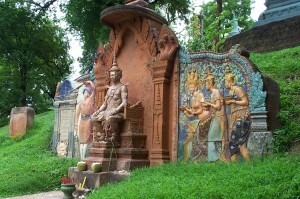 Political pragmatism means policy, platform, or political actions that are realistic and practical. It stems from combining all factors in order to select the best one.
Political pragmatism means policy, platform, or political actions that are realistic and practical. It stems from combining all factors in order to select the best one.
For Cambodia, political culture of pragmatism should follow the 10 factors taught by the Buddha. Do not go upon what has been acquired by repeated hearing ; nor upon tradition; nor upon rumor ; nor upon what is in a scripture ; nor upon surmise; nor upon an axiom; nor upon specious reasoning; nor upon a bias towards a notion that has been pondered over; nor upon another’s seeming ability; nor upon the consideration, “The monk is our teacher.” Kalamas, when you yourselves know: “These things are good; these things are not blamable; these things are praised by the wise; undertaken and observed, these things lead to benefit and happiness,” enter on and abide in them.’ – Kalama Sutta
Leaders must design the future by using past lessons to observe the present movement. Cambodia has already experienced sweet and bitter for all leaders to achieve their future framework.
Posted in Culture, Economics, Education, KR Trial, Leadership, Politics, Researches | Comments Off on Political Paradigm of Pragmatism from Khmer Youth part 16
Tags: Political Leadership of Skills, Political Paradigm of Pragmatism
Cambodia’s Enigma by John Tully
ប្រាងប្រាសាទខ្មែរនិងរបបវាលពិឃាដ ទឹកទន្លេស័ក្តិសិទ្ធនិងព្រៃឈេីដេីរលុយមិនរួច អតីតកាលដែលពោរពេញទៅដោយភាពមហស្ចារ្យនិងភាពអម៉ាស….ប្រទេសកម្ពុជាគឺដែនដីនៃទឡ្ហីកម្ម។ សហស្សវត្សន៍កន្លងផុតទៅ ទីនេះគឺជាមហាអាណាចក្ររីកចំរេីនខ្ពស់ត្រដែតប្រកបដោយអំណាច ស្ថាបនាទីធ្លាប្រាសាទដ៏ធំស្កឹមស្កៃ។ សព្វថ្ងៃនេះ មួយពាន់ឆ្នាំកន្លងមក ត្រូវបានបំផ្លិចបំផ្លាញដោយជំលោះនិងសង្គ្រាមមហាវិនាសកម្ម ប្រទេសខ្មែរកំពុងតស៑ូក្រាញននៀលដេីម្បីប្រជាធិបតេយ្យ ហេីយស្ថិតក្នុងតំបន់ទាបបំផុតនៃចរន្តសេដ្ឋកិច្ចពិភពលោក។ កម្ពុជានៅជាប្រស្នាសំងាត់គួរអោយចាប់អារម្មណ៍សំរាប់ពិភពខាងក្រៅ។ ជាមួយនឹងទំព័រប្រវត្តិសាស្រ្តគួរអោយរន្ធត់នៃសង្គ្រាម ភាពអត់ឃ្លាន និងអំពេីឈ្លានពានបរទេសដែលបានគំរាមទៅរកមរណៈភាព ភាពបន្តដង្ហេីមរស់របស់កម្ពជាគឺជាសក្ខីភាពរបស់មនុស្សជាតិក្នុងការប្រឹងរស់អោយខាងតែបាន។ ដោយចន ធូលី ៚ បកប្រែដោយសេង សុភ័ណ
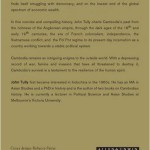 Temples and killing fields, mighty rivers and impenetrable forests, a past filled with glory and decline…Cambodia is a land of contrasts. A millennium ago it was an empire at the height of its power, building the vast temple complexes of Angkor. Now, a thousand years later, ravaged by conflict and a genocidal civil war, Cambodia finds itself struggling with democracy, and on the lowest end of the global spectrum of economic wealth.
Temples and killing fields, mighty rivers and impenetrable forests, a past filled with glory and decline…Cambodia is a land of contrasts. A millennium ago it was an empire at the height of its power, building the vast temple complexes of Angkor. Now, a thousand years later, ravaged by conflict and a genocidal civil war, Cambodia finds itself struggling with democracy, and on the lowest end of the global spectrum of economic wealth.
Cambodia remains an intriguing enigma to the outside world. With a depressing record of war, famine and invasion that have all threatened to destroy it, Cambodia’s survival is a testament to the resilience of the human spirit.
By John Tully (2005) in his book “A Short History of Cambodia: from Empire to Survival”.
Posted in Culture, Economics, Education, Leadership, Politics, Researches, Social, Tourism | Comments Off on Cambodia’s Enigma by John Tully
Tags: David Chandler, John Tully, Sorpong Peou












